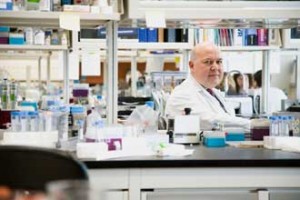
By Mark Shainblum
McGill scientists watched the universe “recycle” a star, learned how to reverse multiple sclerosis in mice and diagnose Alzheimer’s disease early, and shattered the conventional wisdom that all the cells in the body are identical. So what did you do on your summer vacation?
Your cells AREN’T all the same
One of the most cherished assumptions of human genetics – that when it comes to DNA, every cell in the body is essentially identical to every other cell – has been challenged by a group of McGill researchers.
Dr. Morris Schweitzer, Dr. Bruce Gottlieb and Dr. Lorraine Chalifour and colleagues at the Lady Davis Institute and McGill have discovered that specific genes in blood and tissue samples taken from the same patients are different. This finding has ominous implications for ambitious genetic studies which rely only on blood samples.
“Unfortunately, these large genome-wide association studies have been disappointing, and our discovery certainly could explain at least one of the reasons why,” said Gottlieb.
The researchers were investigating BAK, a gene that causes cell death, and its role in the onset of abdominal aortic aneurysms (AAA), an often-fatal vascular disease. To their surprise, the researchers discovered major differences between BAK genes in blood cells and tissue cells coming from the same individuals, with the suspected disease “trigger” residing only in the tissue.
The study may lead to new therapies for AAA and other vascular diseases like heart disease and stroke, but Gottlieb’s focus is the larger genetic discovery.
“From a genetic perspective, therapeutic implications aside, the observation that not all cells are the same is extremely important. That’s the bottom line,” he said.
Star light, star bright,
a recycled star I see tonight
Astrophysics PhD candidate Anne Archibald and her supervisor, Prof. Victoria Kaspi of the McGill Pulsar Group, observed a singular cosmic act of rebirth: the transformation of an ordinary, slow-rotating pulsar into a superfast millisecond pulsar with an almost infinitely extended lifespan. The discovery was made during a large radio sky survey by an international team of astrophysicists, and was published in Science.
“This survey found many new pulsars, but this one is truly special – a very freshly ‘recycled’ pulsar that is emerging straight from the recycling plant,” said Archibald.
Pulsars are rapidly rotating, highly magnetized neutron stars, the remnants left after massive stars have exploded as supernovae. “We know normal pulsars typically pulsate in the radio spectrum for one million to ten million years, but eventually they slow down enough to die out,” explained Kaspi. “But a few of these old pulsars get ‘recycled’ into millisecond pulsars. They end up spinning extremely fast, and then they can pulsate forever. How does nature manage to be so green?”
Catching Alzheimer’s disease in the act
Dr. Hyman Schipper and colleagues developed a new diagnostic technique that may greatly simplify the detection of Alzheimer’s disease. The researchers at the McGill-affiliated Lady Davis Institute Medical Research of the Jewish General Hospital utilized a new technique to identify changes in the blood plasma of Alzheimer’s patients – changes which can be detected very early after onset, and possibly in pre-clinical stages of the disease.
There is currently no accepted blood test for Alzheimer’s, and diagnosis is usually based on expensive and labour-intensive neurological, neuro psychological/imaging evaluations, which are not effective until the disease is well-advanced. “The advent of a simple blood test for the diagnosis of early Alzheimer’s would represent a major achievement in the management of this
devastating disorder,” Schipper said.
A new front in the war on MS
McGill researchers have struck what may be the penultimate blow in the war against multiple sclerosis (MS.) A new experimental treatment completely reverses the devastating autoimmune disorder in
mice and might work in humans.
MS is an autoimmune disease in which the body’s own immune response attacks the central nervous system, as if the body had become allergic to itself, leading to progressive physical and cognitive disability.
The new treatment, GIFT15, puts MS into remission by suppressing the immune response. The discovery was made by a team led by Dr. Jacques Galipeau at the Lady Davis Institute.
GIFT15, explained Galipeau, converts B-cells — a common form of white blood cell normally involved in immune response — into powerful immune-suppressive cells.
“GIFT15 can take your normal, run-of-the-mill B-cells and convert them — in a Superman or Jekyll and Hyde sort of way — into super-powerful B-regulatory cells,” Galipeau said. “We took normal B-cells from mice, and sprinkled GIFT15 on them, which led to this Jekyll and Hyde effect.”
